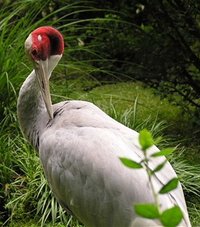Crane (bird)
|
|
| Cranes | ||||||||||
|---|---|---|---|---|---|---|---|---|---|---|
 Sarus Crane | ||||||||||
| Scientific classification | ||||||||||
| ||||||||||
| Genera | ||||||||||
Cranes are large, long-legged and long-necked birds of the order Gruiformes, and family Gruidae. Unlike the similar-looking but unrelated herons, cranes fly with necks outstretched, not pulled back. Most have elaborate and noisy courting displays or "dances". They mate for life. Some species of cranes migrate over long distances, while cranes in warm climates do not migrate at all. Cranes are gregarious, forming large flocks where their numbers are sufficient.
Everywhere crane numbers are diminishing. The plight of the Whooping Cranes of North America inspired some of the first US legislation to protect endangered species.
They are opportunistic feeders that may change their diet according to the season. They eat suitably sized prey such as small rodents, fish and amphibians, but will eat grain and berries during late summer and autumn (the cranberry is so-named from its being extensively eaten by some northern species of crane).
There are representatives of this group on all the continents except Antarctica and South America.
| Contents |
Myth and Lore
The cranes' beauty and their spectacular mating dances have made them highly symbolic birds from earliest times. Crane myth is as widely separated and universal as the Aegean, South Arabia, Japan and Amerindian North America. In northern Hokkaido, the women of the Ainu people, whose culture is more Siberian than Japanese, performed a crane dance that was captured in 1908 in a photograph by Arnold Genthe. In Korea, a crane dance has been performed in the courtyard of the Tongdosa Temple since the Silla Dynasty (646 CE).
In Mecca, in pre-Islamic South Arabia, the three daughters of the moon god Hubal, the three goddesses who would intercede with Allah, were the "three exalted cranes" (gharaniq).
The Greek for crane is geranion, which gives us the Cranesbill, or hardy geranium. The crane was a bird of omen. In the tale of Ibycus and the cranes, a thief attacked Ibycus (a poet of the 6th century BCE) and left him for dead. Ibycus called to a flock of passing cranes, who followed the murderer to a theater and hovered over him until, stricken with guilt, he confessed to the crime.
A crane is the Egyptian hieroglyphic symbol for the letter "B." Also, the word "pedigree" comes from the Old French phrase, "pie de grue", which means "foot of a crane", as the pedigree diagram looks similar to the branches coming out of a crane's foot. The historical Aztec people of South America get their name from cranes. Aztecs are people from the region Aztlan which literally means "near the cranes" (azta cranes, tlan near).
A crane is considered auspicious in Japan, as one of the symbols of longevity and represented with other symbols of long life, the pine and bamboo, and the tortoise. In feudal Japan the crane was protected by the ruling classes and fed by the peasants. When the feudal system was abolished in the Meiji era of the 19th century, the protection of cranes was lost. With effort they have been brought back from the brink of extinction. Japan has named one of their satellites tsuru (crane, the bird). If one folds 1000 origami cranes, according to tradition, one's wish for health will be granted. Since the death of Sadako Sasaki this applies to a wish for peace as well.
For traditional Chinese 'heavenly cranes' (tian-he) or 'blessed cranes' (xian-he) were messengers of wisdom. Legendary Taoist sages were transported between heavenly worlds on the backs of cranes.
Lightmatter_crane.jpg
Sandhillcranes81.jpg
Myth and Lore links
- Crane mythologies (http://www.blueroebuck.com/crane.htm). Not selective, a starting point
- Crane Dance at the Tongdosa Temple (http://www.yscity.or.kr/yangsan-city/sub_1doc/e_sub/sub4/main_01_4.htm)
- Thousand Cranes (http://rosella.apana.org.au/~mlb/cranes/lore.htm#Family) lore.
Classification
- ORDER GRUIFORMES
- Family Aramidae - Limpkin
- Family Psophiidae - trumpeters
- Family Rallidae - rails and crakes
- Family Heliornithidae - finfoots and sungrebes
- Family Rhynochetidae - Kagu
- Family Eurypigidae - Sunbittern
- Family Cariamidae - seriemas
- Family Otidae - bustards
- Family Gruidae: cranes
- Common Crane, Grus grus, also known as the Eurasian Crane
- Sandhill Crane, Grus canadensis
- Whooping Crane, Grus americana
- Sarus Crane, Grus antigone
- Brolga, Grus rubicunda
- Siberian Crane, Grus leucogeranus
- White-naped Crane, Grus vipio
- Hooded Crane, Grus monacha
- Black-necked Crane, Grus nigricollis
- Red-crowned Crane, Grus japonensis
- Blue Crane, Anthropoides paradisea
- Demoiselle Crane, Anthropoides virgo
- Black-crowned Crane, Balearica pavonina
- Grey-crowned Crane, Balearica regulorum
- Wattled Crane, Bugeranus carunculatus
See also
External links
- Saving Cranes website (ICF) (http://www.savingcranes.org/)
- Craneworld website (http://home.nikocity.de/craneworld/index_en.htm)bg:Жеравови
da:Traner de:Kraniche eo:Gruo es:Grulla fr:Grue (oiseau) he:עגורים li:Kroenekrane nl:Gruidae pl:Żurawiowate zh:鹤科
